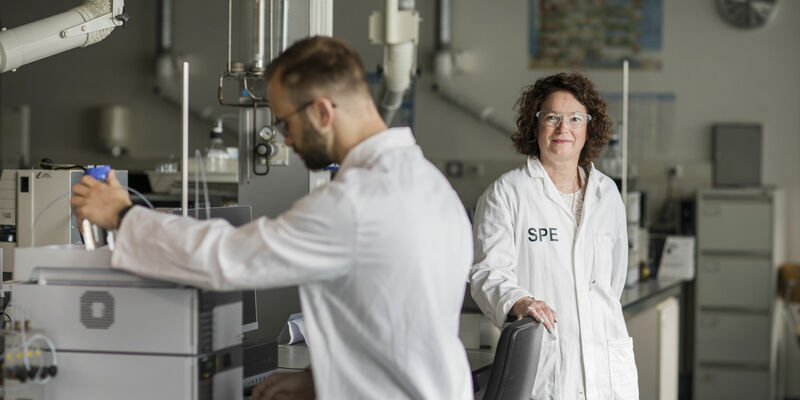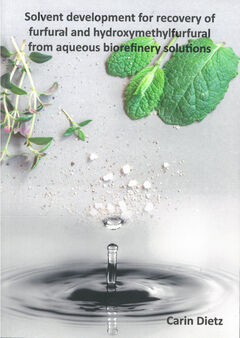
- Research
- 26/06/2019
Scientific late-bloomer awakens sleeping beauty
From a girl who went to lower secondary school, via chemical analyst to Doctor: Carin Dietz has come a long way. On Friday the 28th of June, the mother of two adult children will obtain her doctorate from the Department of Chemical Engineering and Chemistry, where she developed new, eco-friendly methods to extract raw materials from biomass.
Carin Dietz is a special PhD candidate for several reasons. First, she has a quarter century of experience in scientific research, and her two children Guido and Fabiènne will be assisting her as ‘paranymph’ during her PhD ceremony. These sprigs were the reason why Dietz said no to professor Jos Keurentjes a long time ago when he offered her to take her PhD with him. “They were very young at the time, and I decided that I couldn’t combine family and work.”
She worked as a research assistant at the lab of Keurentjes at the time and had already come a long way, she says. “Perhaps I am what you could call a late-bloomer: I went to lower secondary school, where a teacher advised me to become an analyst. So, I studied to become a laboratory technician at an institute of secondary vocational education. I had to test the same samples every day during an internship, but that didn’t even start to fill my day.”
Although she managed to get a job as an assistant in another lab, Dietz realized that this monotonous work would not make her happy. “That’s why I went on to study for laboratory technician at an institute for higher vocational education (HLO). The internship I took at AKZO as part of that program suited me much better. That work had a clear objective, for which I had to go to different departments. I like variety and I establish contacts easily, so I was going from one place to another and I really enjoyed that.”
Friday afternoon
Dietz found a position in Wageningen, even before she graduated from the HLO in 1993, at what is now known as Wageningen Research, where she worked on biopolymers. “We were looking for proteins as an alternative to plastic, for instance for wall paints, glues, coatings for cheese and cars; anything you can come up with. We also had our so-called Friday afternoon experiments there, where we tried out some ideas. They would always ask me: Carin, could you find out if that’s possible?”
Her affiliation with TU/e started in 2001, when Dietz, who was born in Venray, redirected her attention southwards. In the group of the aforementioned Keurentjes, she assisted several PhD candidates with her experience with practical chemistry, and with analysis in particular: determining exactly which substance you made. That skill is neglected nowadays at the Department of Chemical Engineering and Chemistry, Dietz says, which is a source of frustration for her.
To me, analysis is the most important part of your research, if you don’t know what it is you are dealing with exactly, you don’t know anything
“To me, analysis is the most important part of your research, if you don’t know what it is you are dealing with exactly, you don’t know anything. The majority of the PhD candidates I assisted stumbled over analysis.” Because that was the last thing the young researchers had on their minds, Dietz stresses, even though it should be the first. “What do I want to know? And how can I measure that? Perhaps that is impossible, in which case there’s no point in starting the experiment.” The art of analysis hasn’t been a part of the curriculum at TU/e for some years now, Dietz says. “It’s just a part of the practical classes now, but that’s hardly enough. I think that’s a real shame.”
Seventeen students
After a two-year stint at process developers Bodec in Helmond, Dietz was asked to return to TU/e in 2014, she recounts. “They couldn’t do without me, they said, and they asked me to please come back.” Her office was in the same hallway as that of Maaike Kroon, who had just been appointed the youngest female professor in the Netherlands. “Not long after that, Maaike asked me to take my PhD with her.”
It was a more favourable time now, but starting as a ‘regular’ PhD candidate after having gained so much experience felt strange, Dietz admits. “It was obvious that I was unlike the others, and I was satisfied with the work I was doing at the time. What eventually made me decide to do it was the fact that I never got a master’s degree. I wanted to teach at a university of applied science one day, and you need a master’s degree for that.” Or a doctoral degree of course. “And I was now in a position where I could decide what kind of research I wanted to do, that was really nice as well.”
In practice, PhD candidate Dietz supervised dozens of students, who performed a part of her lab work for her. “There was a peak moment where I had seventeen students at the same time. There must have been over fifty of them during the last four years.” That’s a lot more than the average PhD candidate could handle, but her doctoral was special in a number of other ways as well.
Abu Dhabi
To start with, it turned out after three days that her intended PhD supervisor Maaike Kroon was going to move to Abu Dhabi. “That was really unpleasant for a moment, because everything suddenly became uncertain. I had turned down two offers for a job as a lab instructor for this PhD position, I had two children and a mortgage, and I was still in my trial period of course.” Fortunately, her project coincided with the groups of Martin van Sint-Annaland and Fausto Galluci. “Martin immediately told me that I was welcome to join his group, even though I was the odd one out because they work with gasses whereas I worked with liquids.”
Dietz conducted much of the lab work in the new lab of Kitty Nijmeijer, who was appointed at TU/e after she left the University of Twente. “In the beginning, one of my tasks was to help get the equipment up and running in the lab. That is a fine lab, and the people there were pleasant to work with. But otherwise, I felt a bit isolated.”
Sleeping beauty
Therefore, it was a good thing that she had enough research experience when she started. In any case, her relative isolation didn’t prevent her from achieving good results. Dietz is certainly very proud of what she has accomplished. “I looked for an eco-friendly liquid that I could use to extract a molecule called furfural from biomass, such as paper or agricultural waste.” Furfural is a so-called platform molecule, she explains, and it can be used to produce plastics and medicines, among other things. “Today we primarily still use fossil fuels to make these products, but we want to get rid of that, of course. Furfural is also known as the ‘sleeping beauty’ in our field, because it can be used to make so many other substances.”
In order to extract that special molecule from biomass, chemists generally use so-called organic solvents. However, these solvents have the disadvantage that they are volatile and toxic; in other words: bad for the environment. That is why Dietz tried to find an eco-friendlier alternative. For some time now, researchers at the Department of Chemical Engineering and Chemistry have been working on so-called ‘deep eutectic solvents’ (DESs), a mixture of substances that, when put together in the right ratio, somewhat magically results in a liquid. “This is a physical process, with the advantage that it's relatively simple to regenerate the components after use. I was specifically looking for bio-based DESs in order to keep it as eco-friendly as possible.”
Thyme and mint
Dietz chose an image of some thyme leaves and mint for the cover of her thesis because these are the ingredients of a DES she conducted research on. “You extract menthol from mint and thymol from thyme. Together they form a DES.” Dietz then added this DES to an aqueous substance containing biomass. The hydrophobic liquid does not mix with water, but is does absorb furfural and the related molecule hydroxymethylfurfural. The DES, with furfural, can then easily be separated from the water. “It turns out that this extraction works three times better than with toluene, which currently is the most commonly used solvent for extraction.” Thymol works especially well, Dietz says. “We’ve learned that this substance in turn can be used to form a DES with furfural, so that you don’t even need a second component.”
The next step is to remove the furfural from the extraction solvent. This is done traditionally through distillation, a highly energy-intensive process. However, Dietz found a way to do this in a much more energy-efficient way by using a special membrane.
The chemist characterizes her research as a “major breakthrough” that will increase the production yield, provided that the process can be scaled up. That is why she finds it surprising that no commercial party has showed an interest yet. “I’ve been told that I should perhaps bring this method to the market myself, but I will not do that. There are several people among my acquaintances who started their own business and I’ve seen how much time and energy it costs; I’m not going to do that. Even my doctoral research, for which I was officially employed for four days a week, probably occupied me six days a week. It’s not easy to balance that with a family life. But if someone decides to play a leading role, I would like to stay involved.”

Discussion